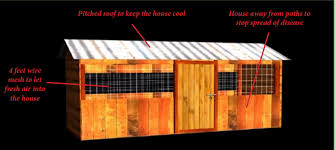Proper kienyeji chicken housing is very important if you are planning to go commercial. If you are keeping chickens and buying them at a very young age, you need to offer a good kienyeji housing structure as this will help limit mortality from cold, draughts and even moderators. There is a certain style that you need to follow when you are building a kienyeji chicken house and this is adequately covered in our Kienyeji Housing Manual which we sell for Ksh.250.

While a Kienyeji Chicken house may seem like a simple structure, building an ideal structure is not as simply as it seems. You need to follow proper specifications when constructing the house. Proper kienyeji chicken housing must meet the following requirements:-
- Be predator-proof, not just from the sides, but from above and below as well. Predators that would love chicken wings for dinner include but are not limited to hawks (be sure to select the right wire mesh. The holes in standard “chicken wire” are actually quite large. Yes, it will keep the chickens in, but small predators can reach through those holes and do some nasty things. We recommend one-half inch square “hardware cloth”.)
- Be secure from nasty rodents (yes, rats!) that will be attracted to the feed and droppings. Rodents are burrowing creatures, so you need to block them from slipping into the coop from below. If you coop doesn’t have a floor, you need to bury small-mesh fencing down into the ground about 12″ all around the coop.
- Be breezy (low in air pressure coming in) enough to prevent respiratory diseases, to which chickens are especially prone, but not so drafty (having cold air moving through in a way that is unpleasant or uncomfortable) during cold season that they freeze their tushes (tooth) off. Chickens can withstand the cold so long as it’s not drafty!
- Be easy to clean so bugs and bacteria don’t fester (make the house rot).
- Provide “roosting poles” for your birds to sleep on (2″ wide; rounded edges; allot 5-10″ of space per bird side to side and 10″ between poles if more than one is necessary; plus ladder-like grading so the pole furthest away is several inches higher than the closest). They like spending time in these positions.
- Encourage egg-laying with 1 nest box for every four or five chickens. Nest boxes should be raised off the ground at least a few inches, but lower than the lowest roosting pole. They should also be dark and “out of the way” to cater to the hen’s instinct to lay her eggs in a safe, place.
- Be roomy: at least 4 square feet per bird if birds are able to roam freely during the day, and at least 10 square feet per bird if they are permanently confined.
- Accommodate a feeder and waterer, which should hang 6-8″ off the ground.
- Include a removable “droppings tray” under roosting poles for capture and easy disposal of droppings. These are rich fertilizer which you can use in your farm or sell to other farmers.
- Similar to the coop, the sides of the attached chicken run, if you have one, should be buried 12″ into the soil to keep predators and rodents from digging their way in. Once again, we recommend chicken wire fencing or half-inch hardware cloth. It’s also our strong recommendation that you secure the top of the run with wire mesh if possible (this is not mandatory). This will keep wild birds (which can carry communicable diseases) out and provide further defense against sly predators.
- Setting the house among tall trees may help prevent aerial attack of young birds by hawks.
FOR A COMPREHENSIVE GUIDE ALONG WITH PICTURES ON HOW TO BUILD A KIENYEJI HOUSE, YOU CAN ORDER YOUR COPY OF KIENYEJI HOUSING MANUAL.